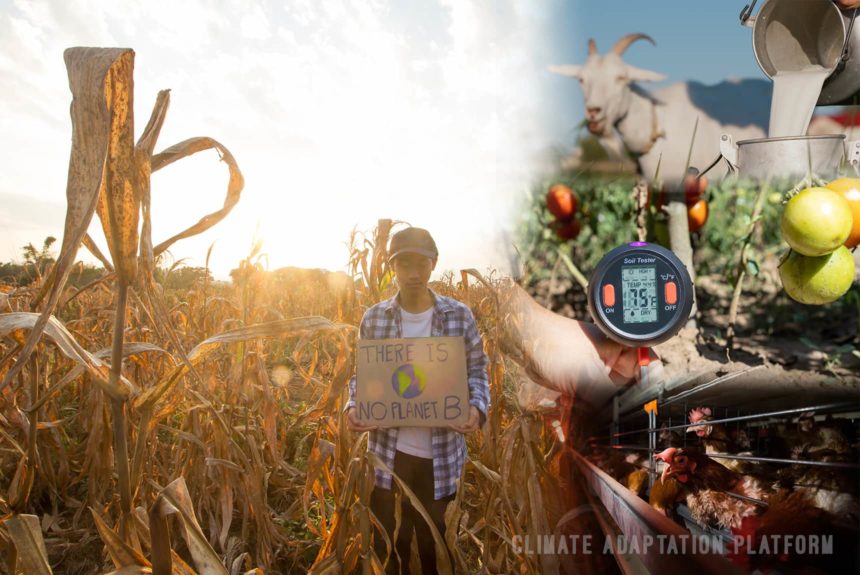NASA monitors how temperatures affected by climate change and the rise in greenhouse gas (GHG) concentration in the atmosphere will impact food production.
The use of an advanced computer model that simulates how the Earth’s climate will respond to continued GHG emissions in the future, then uses the results to determine how it will affect global agriculture.
According to Alex Ruane, Co-Director of the Climate Impacts Group at NASA’s Goddard Institute for Space Studies (GISS) in New York City, climate change differs from the current hot years we experience or a heatwave that raises the overall temperature. Instead, climate change is a daily occurrence, with little by little, increasing temperatures.
He adds that “when those heat waves come in the future, they’re just a little bit more intense or extreme, and that has a different physiological impact on plants.”
These physiological impacts on plants are also complex and depend on the type of crops and the effects of climate on a regional or local area.
The article states that carbon dioxide remains in the atmosphere for hundreds of years and explains how plants utilise it as a fertiliser, as well as which types of crops benefit from higher CO2 concentrations.
However, plants and crops alone are not sufficient to remove all the CO2 accumulated in the atmosphere since the Industrial Revolution.
Crops can grow faster and more prominently with higher CO2 concentrations, but their nutrient content is proportionally lower. Higher CO2 concentrations also increase temperatures, and tropical crops will suffer the most from scorching temperatures.
Climate simulations show that crop production either increases or decreases depending on the region you are in. In cooler climates, yields can increase due to warming; however, in tropical areas, yields can decrease.
The study “Global wheat production with 1.5 and 2.0°C above pre-industrial warming” mentions:
“A 2019 model study simulated future global wheat production with projected global temperatures 1.5 degrees Celsius and 2.0 degrees Celsius above pre-industrial temperatures. Taking into account carbon dioxide’s fertilisation effect, the results showed that grain yields for winter- or spring-planted wheat rose by about 5% in more temperate regions, such as the United States and Europe, and declined by about 2 to 3% in warmer regions, such as Central America and parts of Africa. Additionally, in hot regions including India, which produces 14% of global wheat, they more frequently saw years with low wheat yields.”
Small incremental increases in temperature also accelerate the life cycle of plants, causing them to mature rapidly, which can reduce the quality and quantity of crop yields.
Climate change will also impact rain and snowfall patterns, leading to droughts and rainfall extremes. Some areas will benefit from increased precipitation, but others will receive too much or too little, resulting in adverse effects.
Monsoons will bring more rainfall to Southeast Asia, and drought will become more intense in the Western U.S., Australia, Africa, and Central America.
Receding snowpacks, such as those occurring in the Himalayas and California’s Sierra Nevada, will also impact groundwater levels, irrigation supplies for farmers, and drinking water supplies. Continuous groundwater extraction to cope with droughts will also affect future water supplies, while hot temperatures can increase evaporation in plants, resulting in less water available for them to use.
The article proposes three types of adaptation strategies: “things decided upon every year, such as when to plant and a field’s crop rotation; longer-term investments, such as a new tractor, improved irrigation systems or new irrigation infrastructure in currently rain-fed areas; and transformative actions, such as breeding new crop varieties or responding to large-scale shifts in a population’s diet.”
To read the entire article, click the link below:
Climate change may render some areas in Australia too dry to farm, which means farmers will soon abandon them unless expensive climate adaptation and planning measures are implemented. Climate change is also decreasing farming profitability. According to the Conversation article, agricultural profits have declined by 23% over the last two decades, and this trend is expected to continue into 2020.
“The Australian Bureau of Agricultural and Resource Economics and Sciences (ABARES) predicts that a likely scenario is that overall farm profit will fall by 13% by 2050.” However, profitability will vary across different regions. Western Australia’s profitability is projected to fall by 32%. Higher emissions will also cause profitability to drop by 11% to 50%.
Water availability is a crucial factor in the long-term success of farming, but Australia lacks adequate water infrastructure plans to cope with climate change.
The NSW Auditor-General’s report in September 2020 states that the state had not effectively supported or overseen town water infrastructure planning in regional NSW since at least 2014. The article states that this lack of climate adaptation planning has left at least ten regional NSW cities or towns with virtually no water.
Climate change impacts on agriculture have knock-on effects on the community, resulting in job losses and displacement. To mitigate losses, Australia is investing in climate adaptation.
The federal government is committed to investing A$20 billion in the adoption of new low-emission technologies, while supporting jobs and strengthening the economy, according to the article.
To read more about it, click the link below:
Sources:
NASA at Your Table: Climate Change and Its Environmental Impacts on Crop Growth. (2021, September 2). NASA. Retrieved from https://www.nasa.gov/feature/goddard/esnt/2021/nasa-at-your-table-climate-change-and-its-environmental-impacts-on-crop-growth
Wait, A., & Meagher, K. (2021, September 6). Climate change means Australia may have to abandon much of its farming. The Conversation. Retrieved from https://theconversation.com/climate-change-means-australia-may-have-to-abandon-much-of-its-farming-166098



Leave a Reply